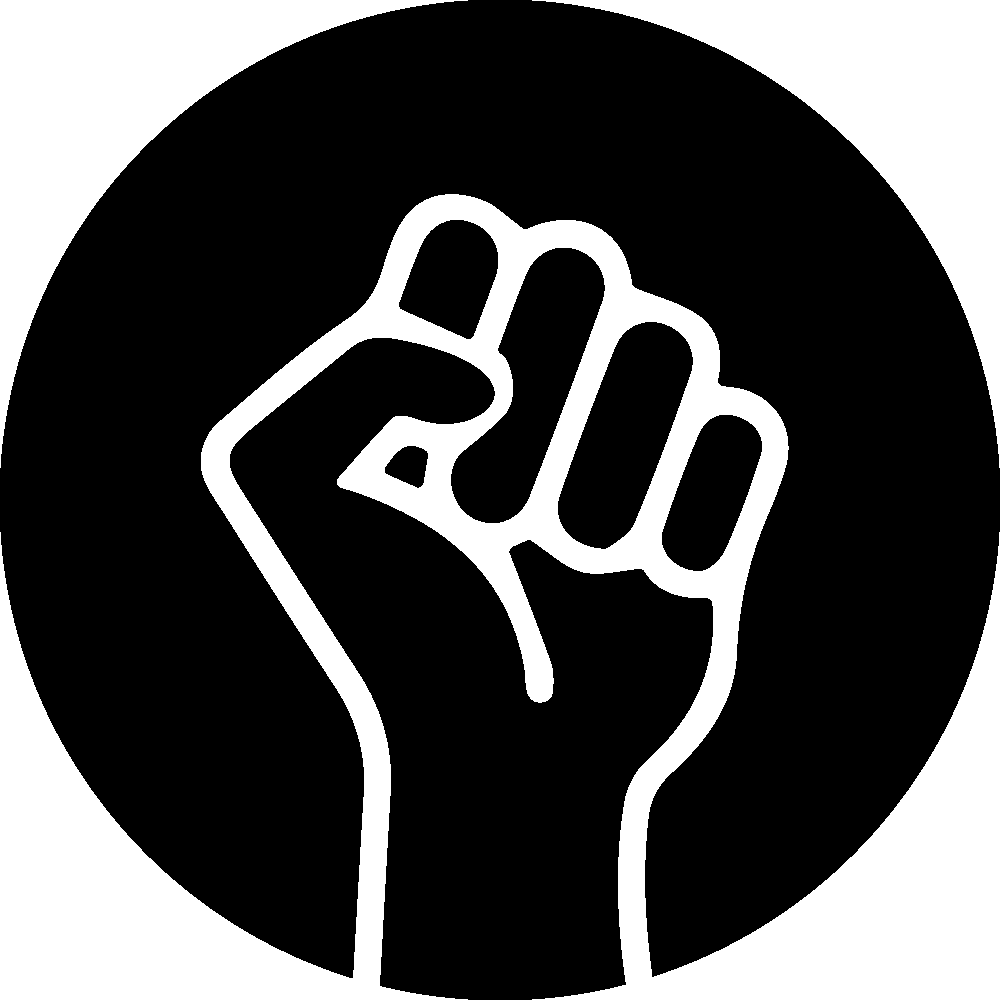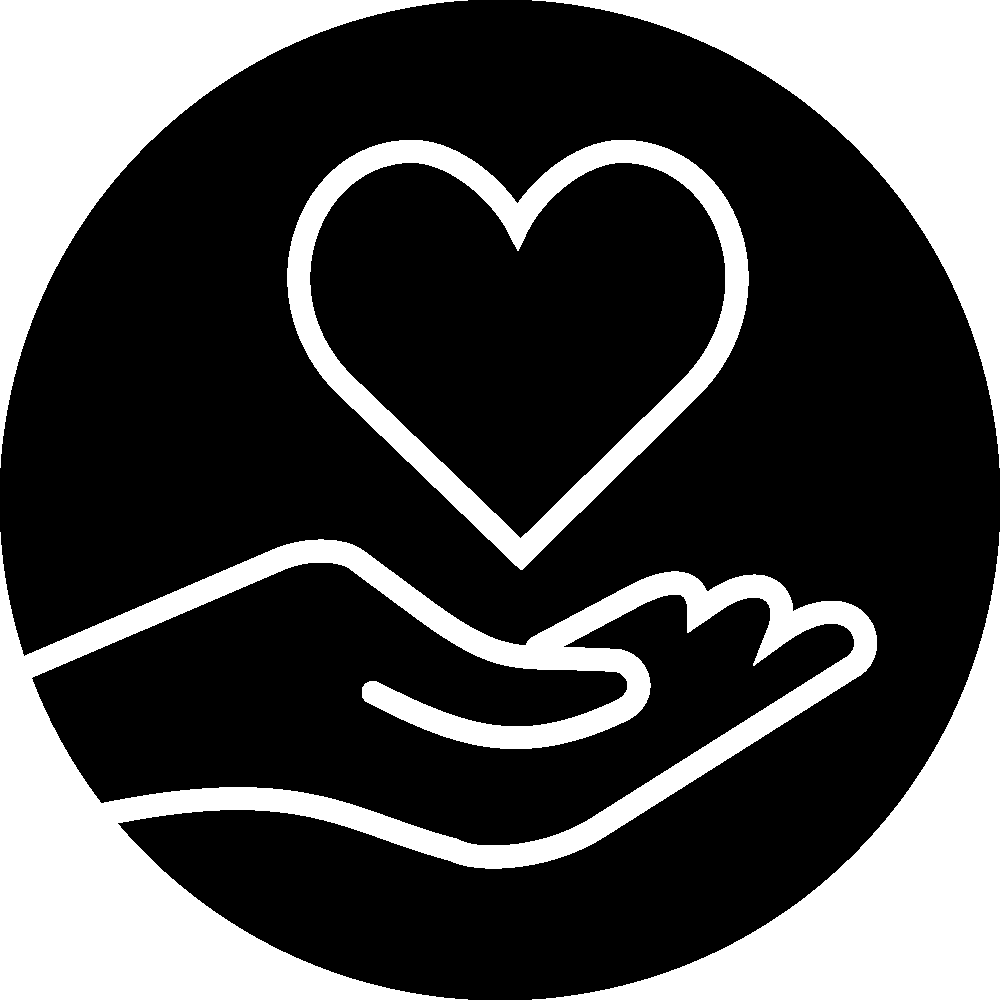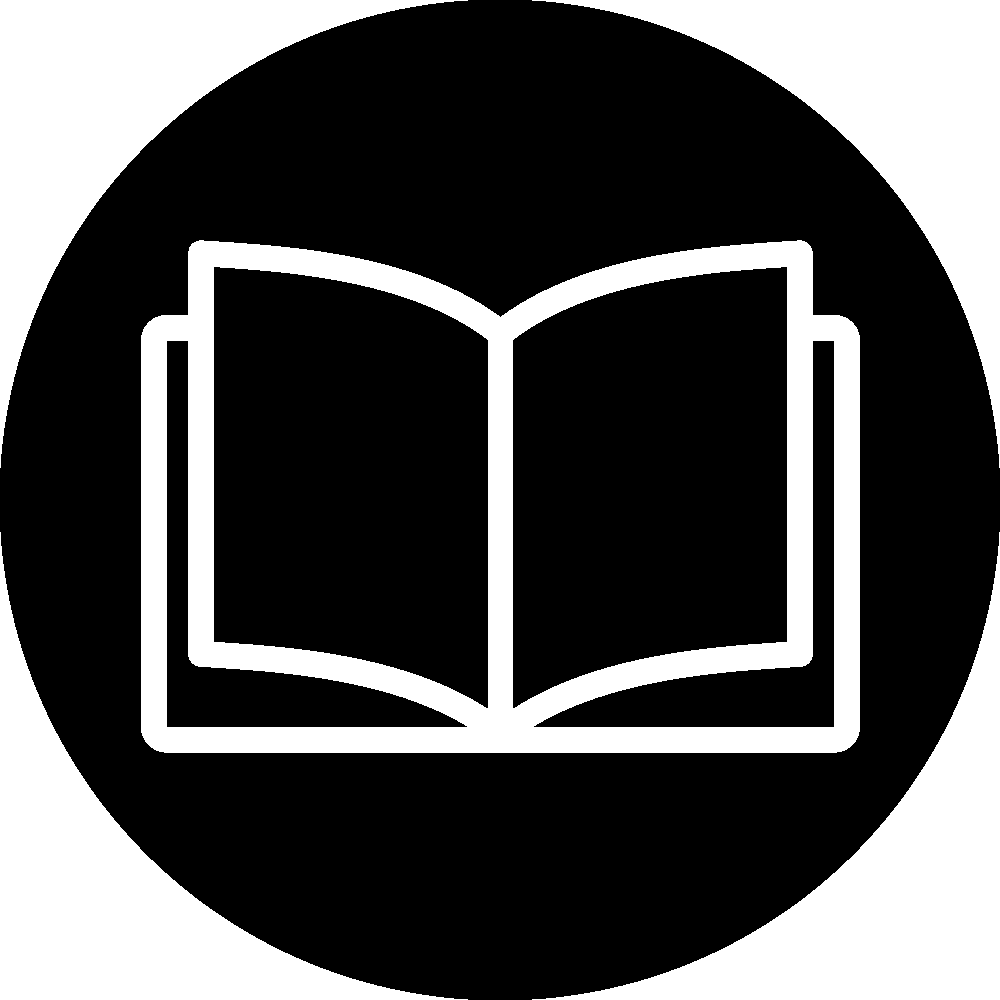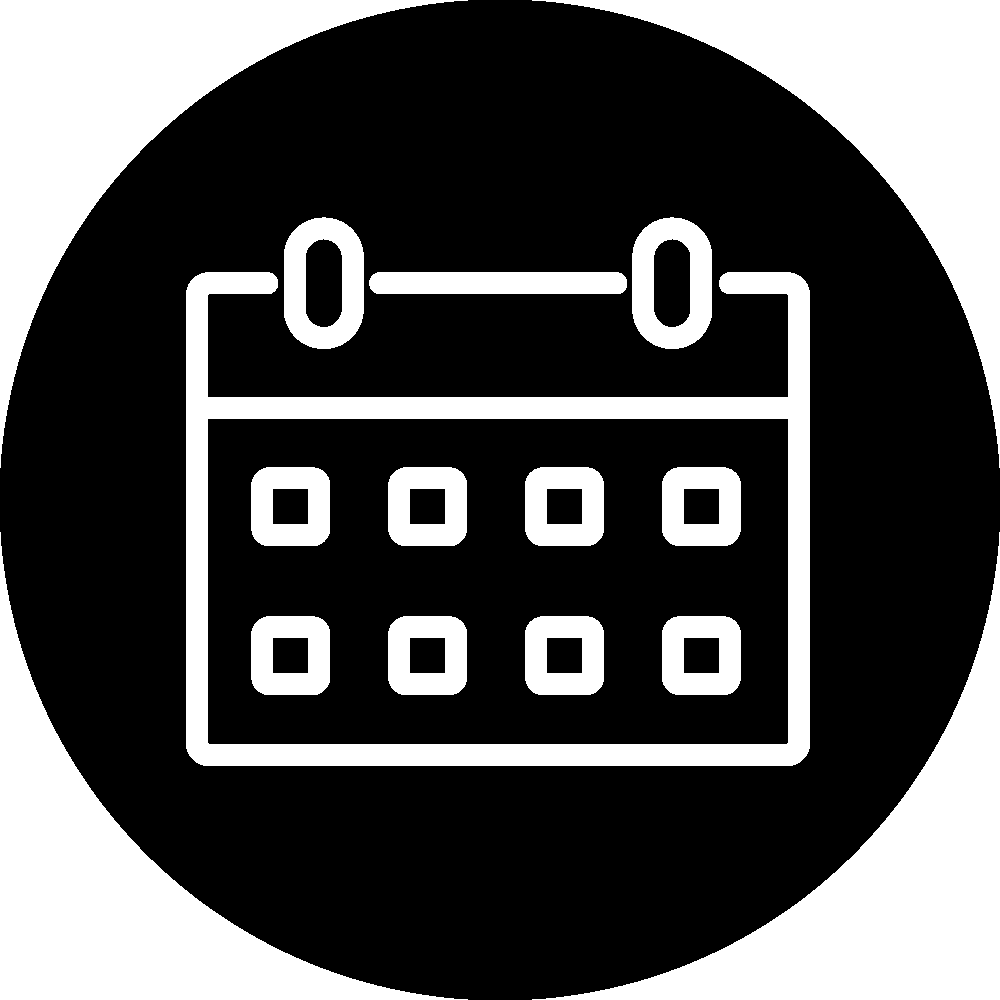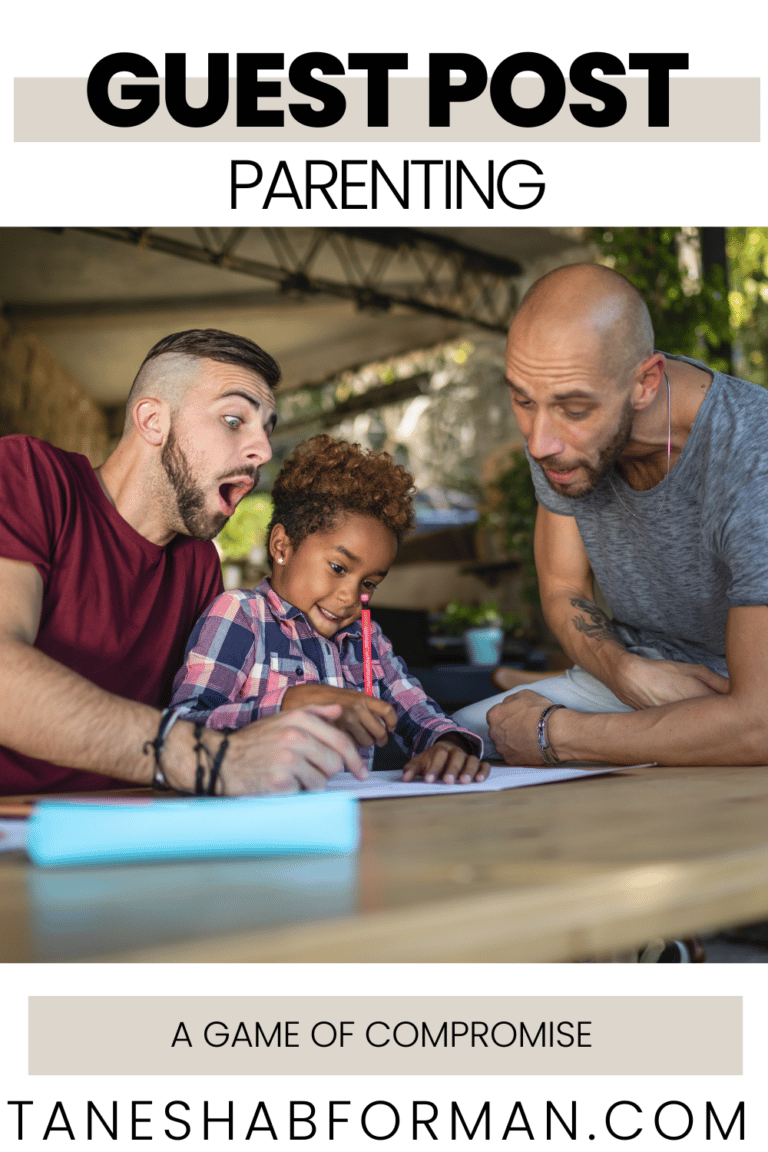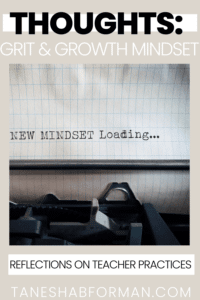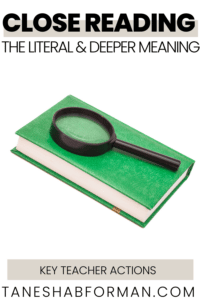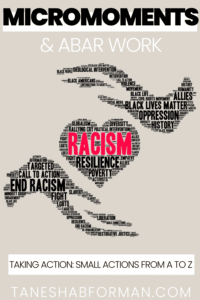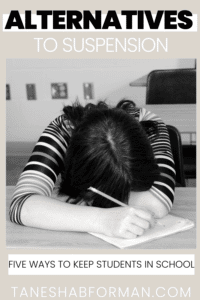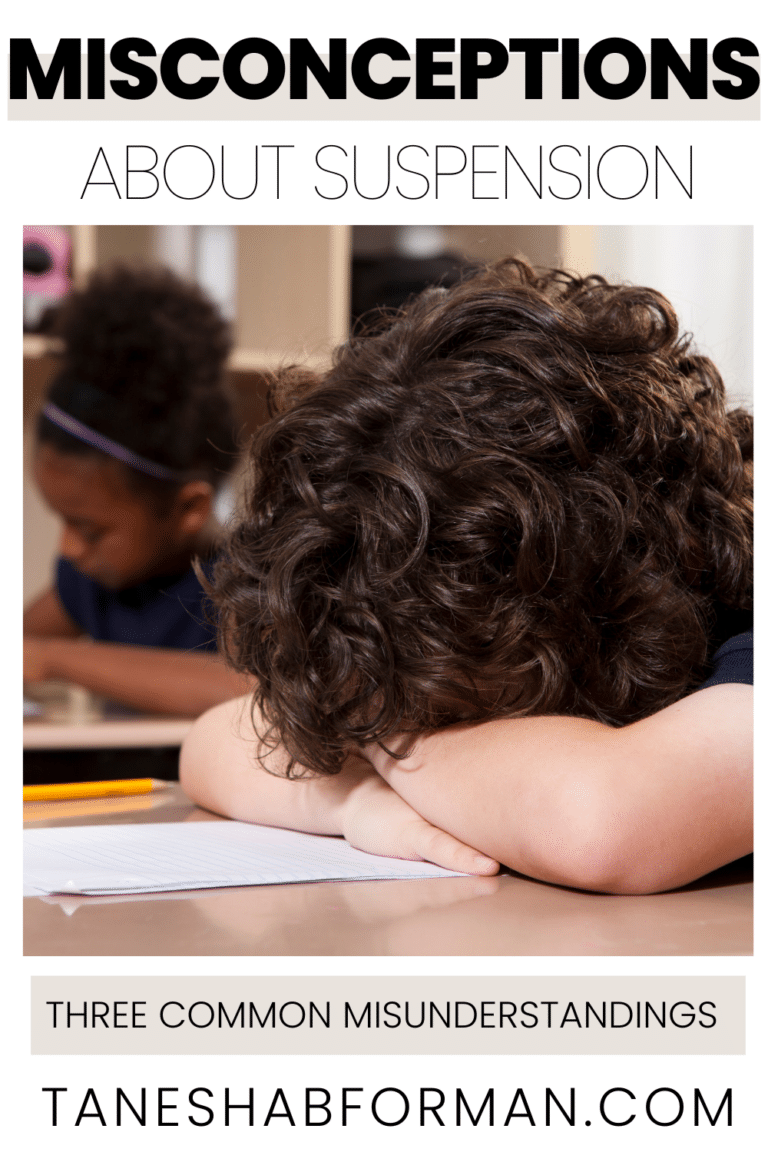
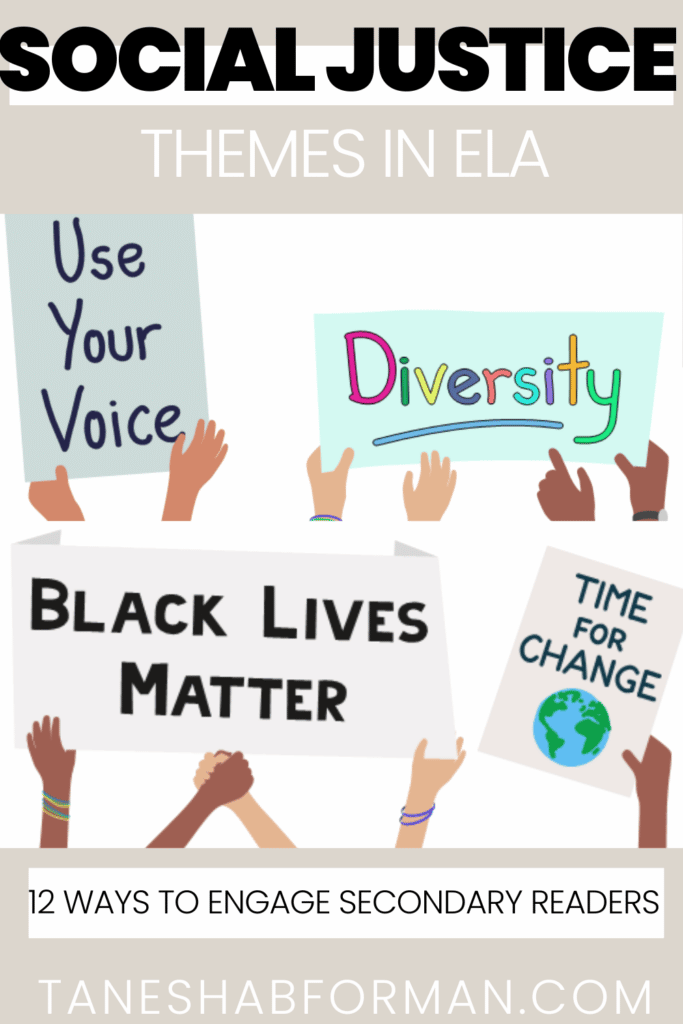
Social Justice Themes & Secondary ELA
Well, 2020 has been a season of learning and critically evaluating our teaching and life practices. As our world works to heal and continuously improve, it’s important to rethink how we are raising the collective consciousness of our classes and empowering students to create and challenge their thoughts and beliefs. It’s not a political manuever, but rather a life skill required to navigate the world.
I’m honored to collaborate with 11 secondary ELA teachers to share ideas and strategies to organically include social justice themes in the classroom.
Unit Planning & essential Questions
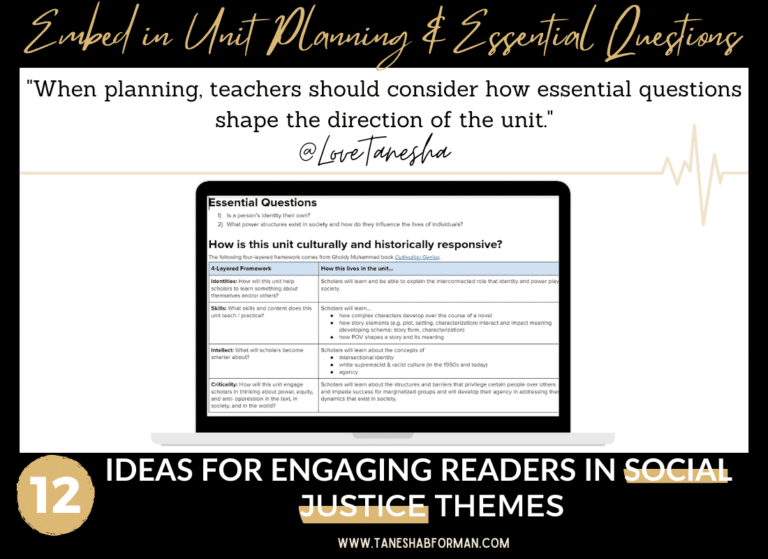
I’ve long held that social and racial justice is not a side-dish, it’s the entrée. Heightened critical consciousness positions students to question and challenge everything. As educators, we have to be intentional about holding space for this. The ability to recognize and analyze systems of inequality can be a gateway to academic success. Therefore, when planning, teachers should consider how essential questions shape the direction of the unit. The start of every unit provides an opportunity for teachers to think through enduring understandings crafted around big questions that ignite and invite deeper levels of analysis and divergent thinking.
To craft essential questions, consider:
- What are the overarching themes connected to the topic of study?
- Are there connections that are debatable and relevant?
- What will students learn about themselves (via strategies) and continue to revisit as learners?
Through the lens above, framing the unit around essential questions lays the foundation for making learning relevant and meaningful, discussing hard topics, and having a long-term impact. There are several tools and books to get started, but I highly recommend Cultivating Genius by Dr. Gholdy Muhammad. Check out examples of essential questions and units from my school that leverage Dr. Muhmmad’s work here.
Native American Literature
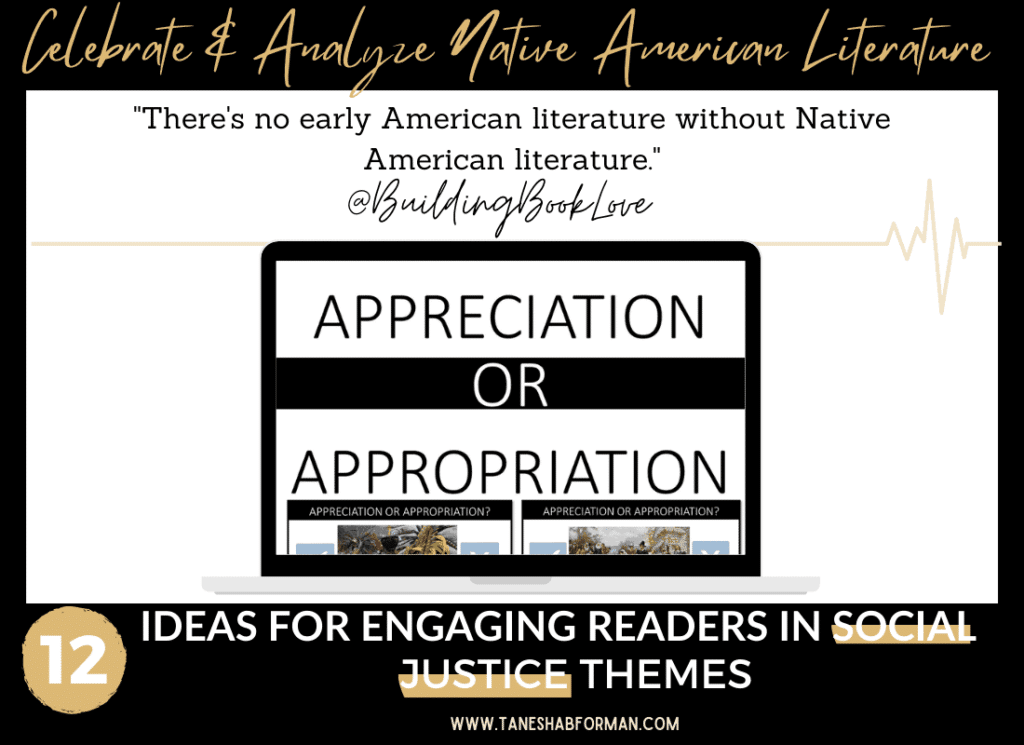
Ashley Bible of Building Book Love believes it is a disservice to teach early American literature without first celebrating and critically analyzing Native American texts. Though several educators are doing the work to eliminate inappropriate Thanksgiving crafts and reenactments at the elementary level, secondary ELA teachers are presented with the perfect opportunity to engage readers in Indigenous social justice themes. A few Native Social Justice themes and ELA Topics Include:
- Creating a rhetoric unit based on important issues like Native American Mascots, Cultural Appropriation, Sacred Native Sites, etc.
- Bringing Indigenous voices into your classroom through podcasts, poetry, and prose.
- Presenting early American voices in a critical light with evidence and exposure.
If you would like more Native justice topics and ideas, this post by Native guest ELA blogger C. Toneekia Hernandez will inspire you: There is no Early American Literature without Native American Literature.
the truth about our clothes
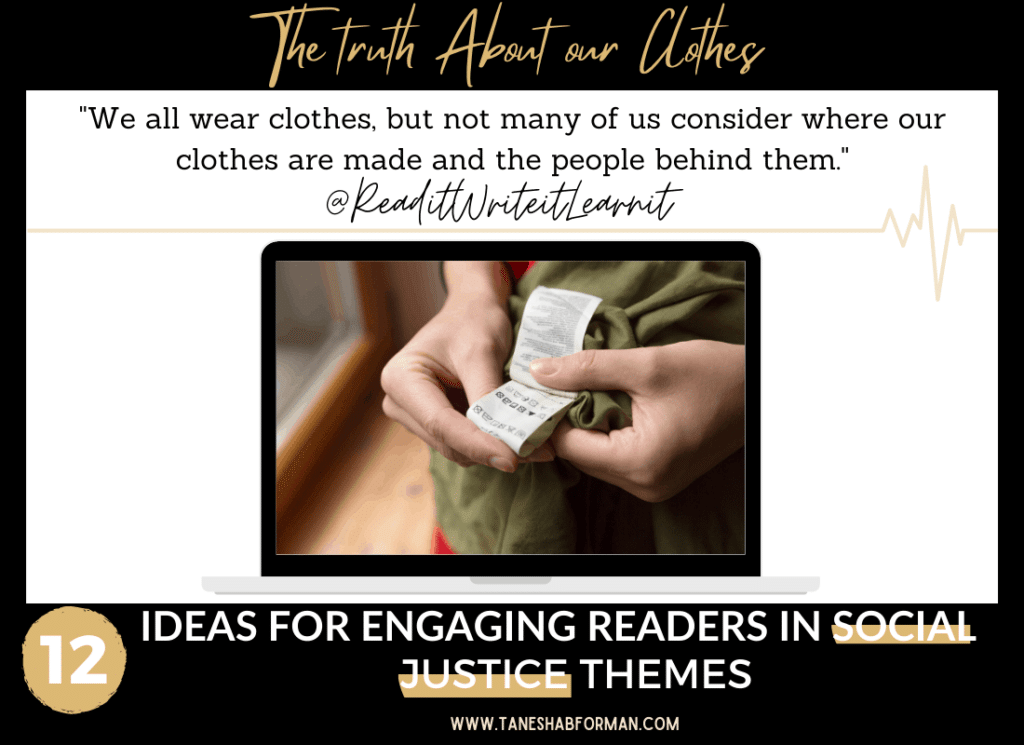
Emily Aierstok from Read it. Write it. Learn it. starts engaging her middle school ELA students in social justice themes by having them check the tags on their clothes. We all wear clothes, but not many of us consider where our clothes are made and the people behind them. When students check the tags on their clothes, Emily plots a map on her Smartboard of the places students’ clothes are made. Students find the same thing each year: very few of our clothes are made in the United States.
Next, students write research questions and begin the process of finding out where our clothes are made and the people behind the labels. As students uncover problems in the fashion industry, they’re encouraged to find solutions (i.e., shopping for ethical clothing, thrifting, and avoiding fast fashion). Students study what it means to make a living wage and the role consumers can play in making a living wage more possible for garment factory workers.
Students work through the research process, then choose a method to share their findings with a larger audience. Students create brochures, podcasts, speeches, posters, videos, and PSAs. The study, called The Truth About Our Clothes, ends with a gallery walk and presentation of student work. After presenting their research, students share a “call to action” for consumers. The goal of this study is not only to practice and perfect research skills, but also to empower young consumers to make a difference in the world.
using photos
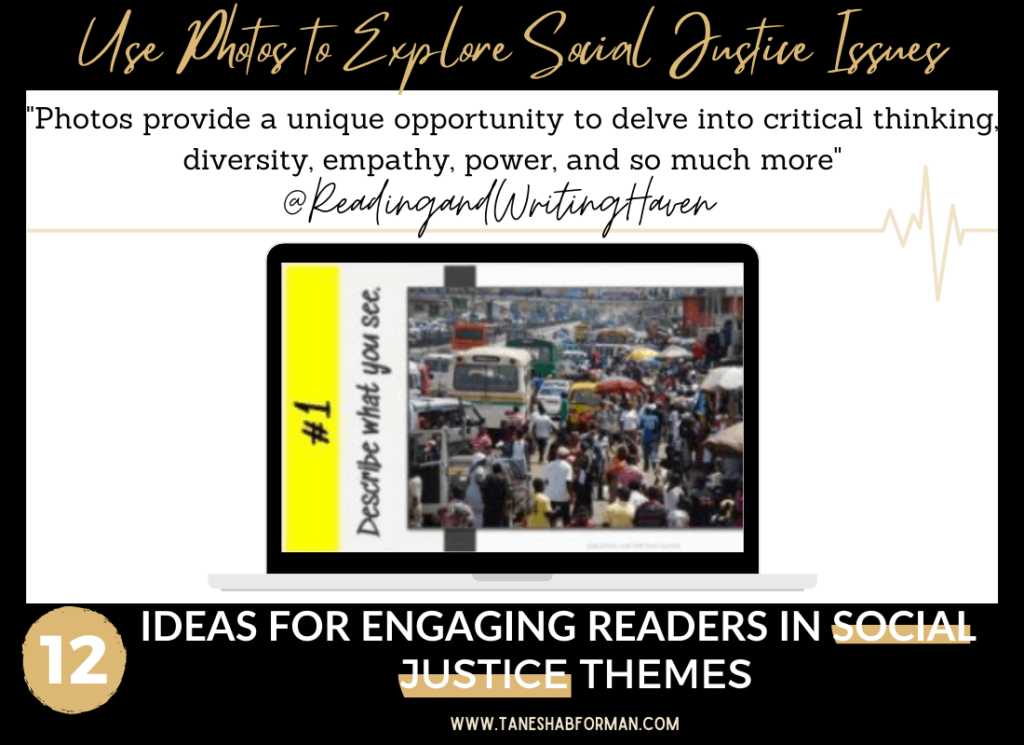
ELA teacher and instructional coach Melissa from Reading and Writing Haven recommends using photos to explore and differentiate social justice issues. Photos provide a unique opportunity to delve into critical thinking, diversity, empathy, power, and so much more. As an introduction to media literacy, for example, students can analyze point of view.
- Why might the photo have been taken at a certain angle?
- What is present, and what is missing?
- What might the photographer have cropped out to portray a certain message?
- How do stereotypes and bias play a role in both the photographer’s point of view as well as the reader’s perspective?
- Ultimately, how can we approach images from a variety of sources in an informed way?
When reading informational texts for a research project, Melissa also encourages students to complement their words with photos via academic photo essays. When researching topics related to social justice, students can incorporate photographs that add value to their writing. The visual element provides an emotional outlet for both the writer and the reader.
You can read more about Melissa’s strategies for using photographs to boost literacy and engage students in meaningful social justice conversations in this blog post.
text and Resource sets
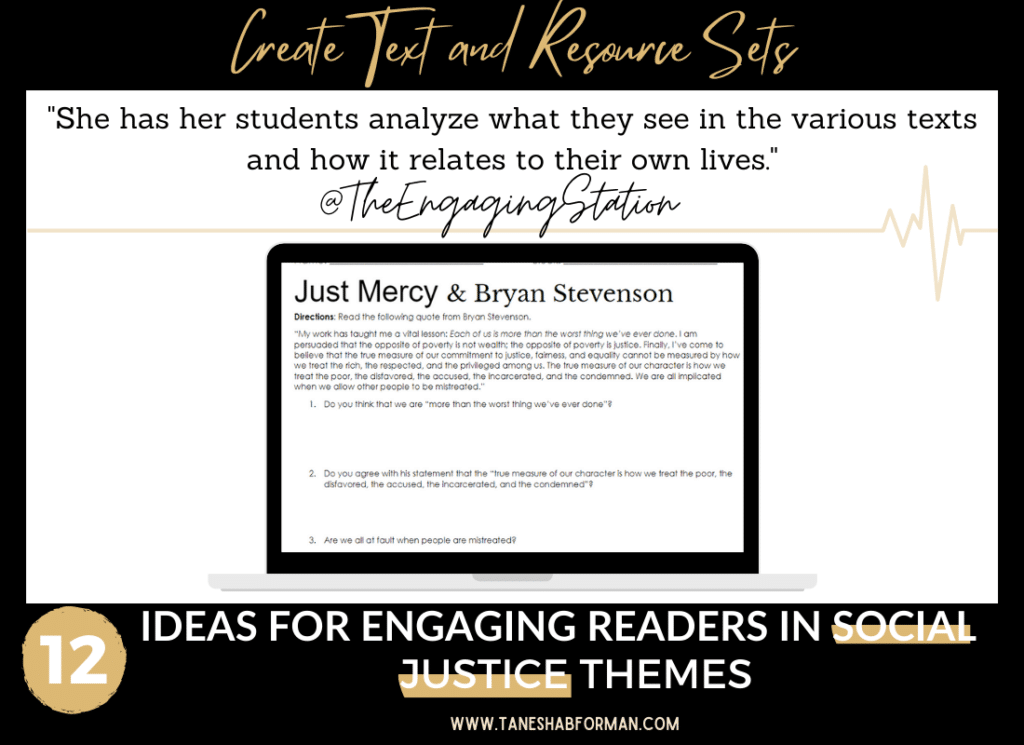
Staci Lamb from The Engaging Station engages her readers with social justice topics and themes by creating a text and resource set complete with novels, short stories, poems, documentaries, podcasts, and more.
For example, when she teaches Just Mercy, a non-fiction novel, she supplements that unit with a YA text Dear Martin, poems by Rudy Francisco, a Criminal podcast on capital punishment, a documentary titled 3 ½ Minutes, 10 Bullets (the story that inspired Dear Martin), and more. In 2020, her students also had the opportunity to see Just Mercy in theaters.
What works for Staci in these units as real and authentic as they can be. Oftentimes, she has her students analyze what they see in the various texts and how it relates to their own lives.
You can check out her ideas and images from this unit on her Instagram and access her free lesson plans and units on her Google Drive.
Picture books & graphic novels
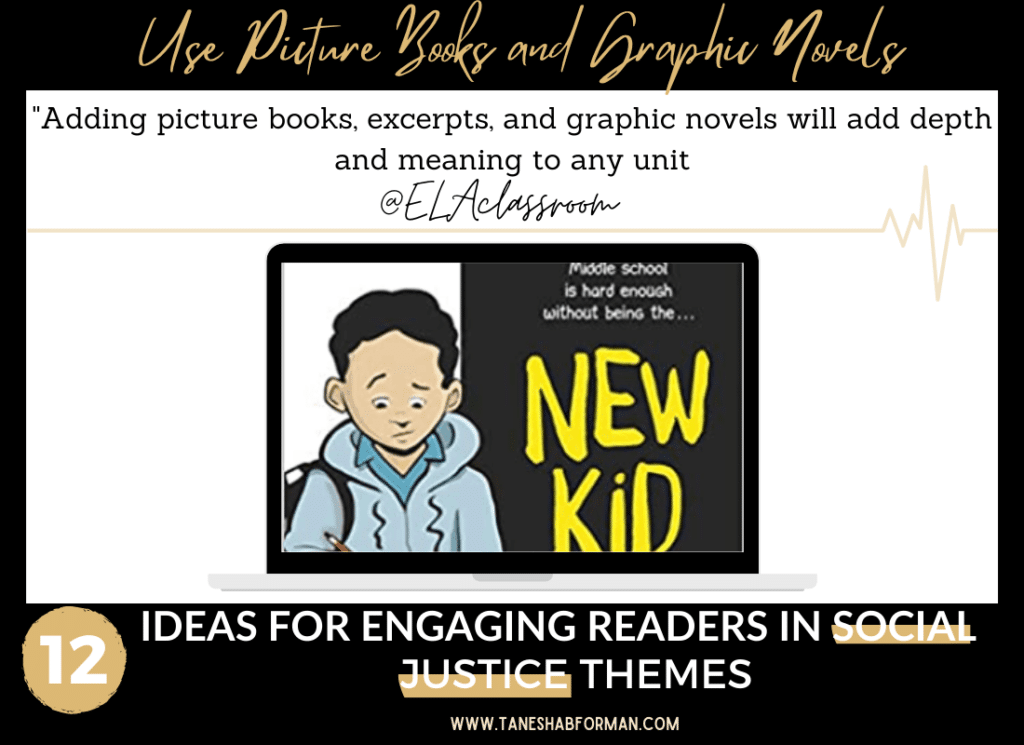
Incorporate picture books, excerpts, and graphic novels to present social justice issues to students. No matter the topic or content, ELA teachers should meaningfully add timely topics to units. Not only will they be connecting to students’ lives, but they will also be enriching the current study.
For instance, Lauralee looks at essential questions as opportunities to place books. New Kid by Jerry Kraft works with essential questions pertaining to power, identities, and culture. Excerpts from Nella Larsen’s writing add to informational text studies regarding treatment of women. Finally, books like How I Resist contain short pieces by popular authors. Use those pieces alongside an author’s literature piece to explore a writer’s social justice motivation in writing.
Adding picture books, excerpts, and graphic novels will add depth and meaning to any unit, essential question discussion, or First Chapter Friday reading.
Poetry
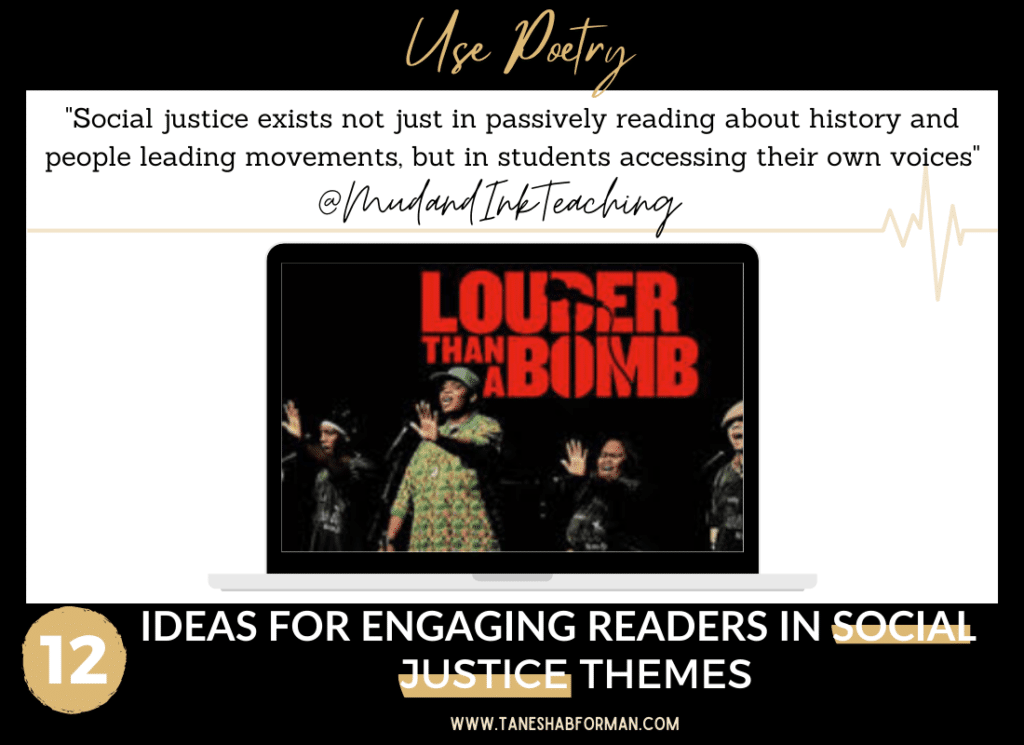
Poetry is a powerful inroad to take any curriculum and move it toward important conversations about social justice. Amanda from Mud and Ink Teaching hosted an interview with me on the Brave New Teaching Podcast addressing this very topic! Students can access these topics in many ways, but Amanda recommends these two specific routes: reading and writing.
Reading poems and/or watching performances from poets that have stories that center on social justice themes is a great place to get started. Slam poetry, in particular, offers highly engaging video and performance opportunities for students. Amanda recommends checking out Malcom London, the Louder Than a Bomb documentary (which started in her home city, Chicago!), Raych Jackson, Brave New Voices, Bobby LeFabre, Kevin Coval, Button Poetry, Miranda Lambert, or anyone on this playlist of performances. Less performative, but still highly engaging “page poets” include Clint Smith, Audre Lorde, and Langston Hughes. Check out her blog post of recommendations of Black poets to bring into your classroom this year.
Social justice exists not just in passively reading about history and people leading movements, but in students accessing their own voices: what better opportunity than to give them the tools to craft their own poetry that vocalizes the issues that matter most to them? Here are 12 ideas for incorporating poetry writing into your classroom and an idea for a Where I’m From Poem that helps students get started with the basics: recognizing where we all come from.
teaching dystopian literature
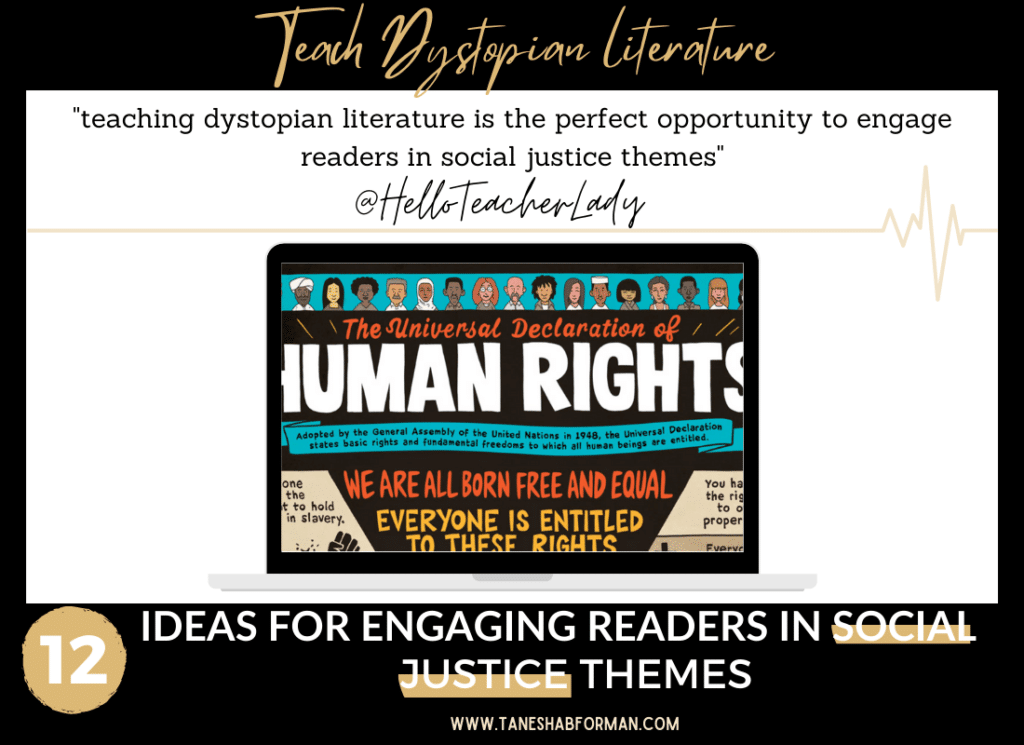
Shana Ramin from Hello, Teacher Lady has found that teaching dystopian literature is the perfect opportunity to engage readers in social justice themes. Every year, Shana’s 8th-grade students choose a dystopian novel series to read (click here for a list of their favorites) as part of their first reading unit. Students participate in weekly book club meetings with their peers for the duration of the unit — exploring dystopian genre conventions, examining how different characters respond to power, and tracking the various internal, external, and systemic issues in their novels.
Throughout the unit, students naturally begin making real-world connections to social issues and current events. To help facilitate this connection, Shana makes sure to introduce students to the Universal Declaration of Human Rights using this cartoon infographic from Zenpencils. Students first examine the cartoon using a “talk to the text” approach, then they respond in writing to one simple question: Which freedoms have the characters in your novel been denied?
Next, Shana introduces this curated Wakelet collection of news articles that contains various parallels to the systemic issues present in students’ novels, such as wealth inequality, censorship, and oppression. This process helps students dig deeper into one of the most fundamental aspects of dystopian literature: the act of social commentary. Shana also gives students the opportunity to find and submit their own articles to the collection, which is a great opportunity for students to further explore social justice themes across literary and real-world contexts.
athletes as changemakers
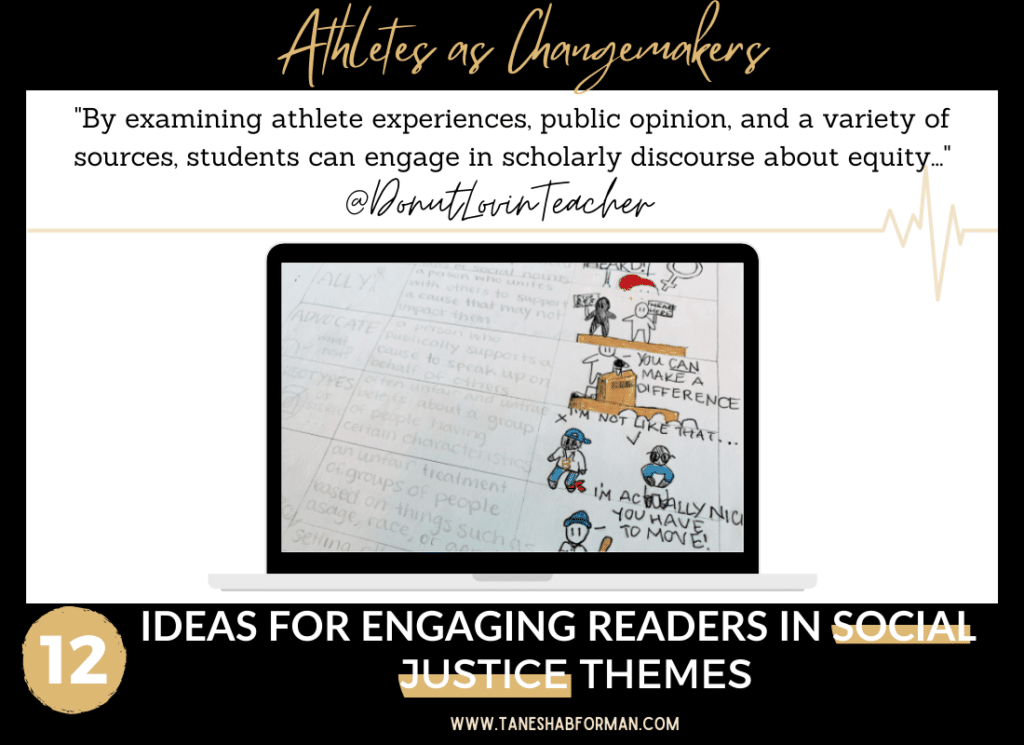
Whether teaching about the Universal Declaration of Human Rights, examining family history, or talking about current events, a strong culture of trust, respect, and growth must be a key value in the classroom community.
Once this foundation is set, Staci from Donut Lovin’ Teacher can engage in meaningful conversations with students about activism and change, specifically by looking at sports and athletes. Many famous athletes, past and present, have demonstrated their ability to raise awareness and commitment to progress in our society. By examining athlete experiences, public opinion, and a variety of sources, students can engage in scholarly discourse about equity, and work to find ways they themselves can enact change.
No matter what grade you teach, you can find helpful tips in this blog post where Staci explains how she incorporated Expeditionary Learning’s free unit, “Athlete Leaders of Social Change,” to guide her students through argumentative writing. She also has a shared folder with links to articles, book club titles, graphic organizers, and project ideas that helped students engage in this work.
Literary Lenses
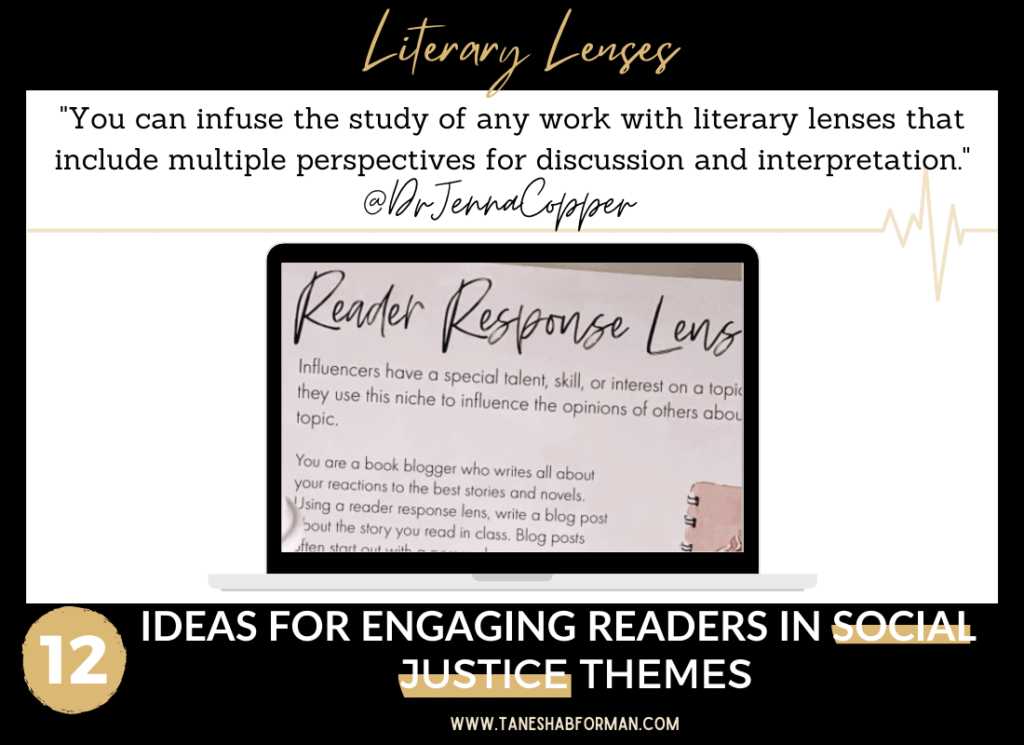
Jenna Copper, @DrJennaCopper, uses literary lenses to engage students in the study of social justice themes and topics. Literary lenses are based on literary theory, which refers to the different schools of literary analysis. Each lens calls for a different perspective to analyze a text. Therefore, you can infuse the study of any work with literary lenses that include multiple perspectives for discussion and interpretation.
Critical race lens, postcolonial lens, gender lens, feminist lens, social class lens, critical disabilities studies lens, historical lens, and ecological lens are excellent companions to engage readers in social justice themes. (Click here for a free resource to get you started with literary lenses!) These lenses are a great way to study social justice themes, diverse perspectives, and under-represented voices, especially when you have a prescribed curriculum set by your school district.
For more information on using literary lenses in the classroom, click here.
paired texts
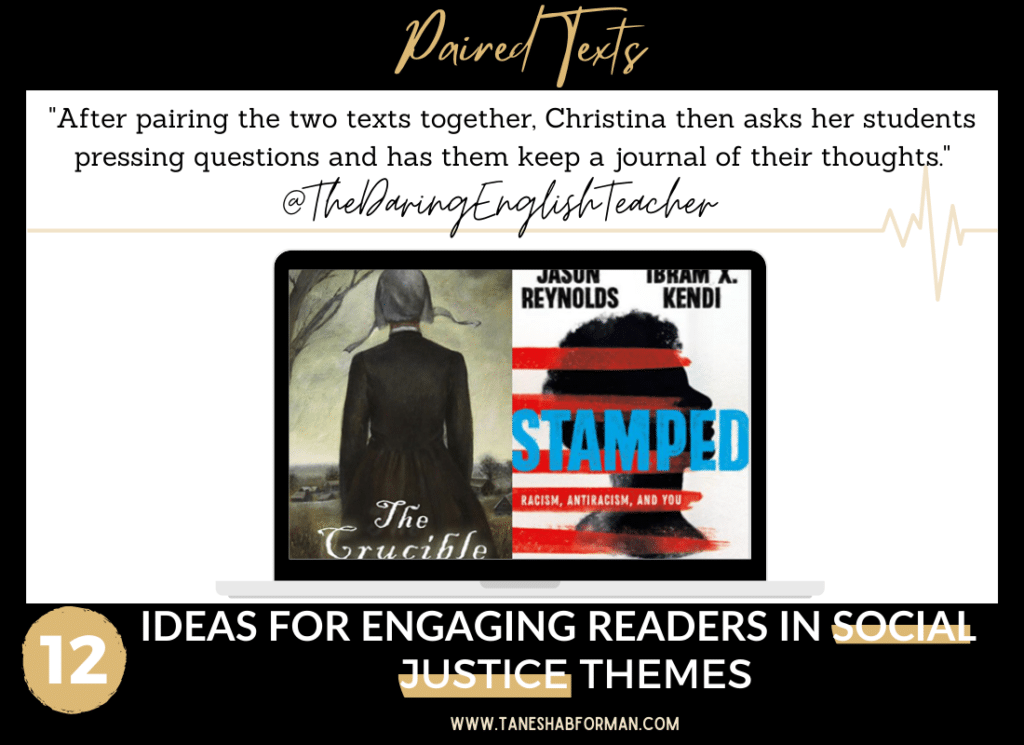
As an American Lit teacher, Christina, The Daring English Teacher, likes to engage students in social justice readings and activities throughout the year. One way to do this is to pair antiracist readings with traditional American Lit texts.
For example, as she reads The Crucible by Arthur Miller, she incorporates chapters from Jason Reynolds and Ibram Kendi’s book Stamped: Racism, Antiracism, and You. In particular, chapters 2 and 4 pair very nicely with The Crucible and other Puritan literature.
After pairing the two texts together, Christina then asks her students pressing questions and has them keep a journal of their thoughts. Some questions she poses to her students include:
- How did reading Stamped challenge your understanding of early American, colonial-American history
- How did reading Stamped challenge your understanding of The Crucible
- What additional context (historical, political, socioeconomical, etc.) did Stamped provide for the play?
- What can society do today to ensure that mass hysteria based on misinformation does not spread?
letters to legislators

Authenticity is key when it comes to engaging students in meaningful social justice work. That’s why Abby from Write on With Miss G loves to incorporate real-life writing by asking students to write letters to their legislators. This authentic twist on traditional persuasive writing is a great way to get students involved in various social justice issues.
Abby recommends exposing students to a variety of topics and sources, and then giving students choice. After that, mini-lessons, mentor texts, and scaffolding will help students find their voice and craft a well-structured letter. Because students know their letter will end up in the hands of a real legislator, they will be more invested in the writing process. After lots of conferring, revision, and editing, students will be ready to address, stamp, and send their letters. The best part: You might even get some responses back in the mail!

PIN FOR LATER!
JOIN THE COLLECTIVE
Sign up and access the FREE resources to support your Anti-Bias/Anti-Racism journey.

Tanesha B. Forman
I'm a current middle school administrator who loves breaking down complex topics and providing opportunities for educators learn, reflect, practice, and implement methods that foster equity and anti-racism. I believe we win together!
Behind the Blog


Hi, I'm Tanesha.
I’m a current middle school administrator who loves breaking down complex topics and providing opportunities for educators learn, reflect, practice, and implement methods that foster equity and anti-racism. I believe we win together!

